 W
WAncistrocerus parietinus is a Palearctic species of potter wasp.
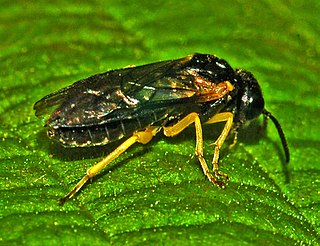 W
WAneugmenus padi is a species of sawfly.
 W
WArgogorytes mystaceus is a species of solitary wasp in the family Crabronidae.
 W
WAtylotus rusticus is a species of horse-flies in the genus Atylotus. It is found in Europe, Asia and North Africa.
 W
WBombus hortorum, the garden bumblebee or small garden bumblebee, is a species of bumblebee found in most of Europe north to 70°N, as well as parts of Asia and New Zealand. It is distinguished from most other bumblebees by its long tongue used for feeding on pollen in deep-flowered plants. Accordingly, this bumblebee mainly visits flowers with deep corollae, such as deadnettles, ground ivy, vetches, clovers, comfrey, foxglove, and thistles. They have a good visual memory, which aids them in navigating the territory close to their habitat and seeking out food sources.
 W
WBombus lucorum, the white-tailed bumblebee, is a species of bumblebee, widespread and common throughout Europe. This name has been widely used for a range of nearly identical-looking or cryptic species of bumblebees. In 1983, Scholl and Obrecht even coined the term Bombus lucorum complex to explain the three taxa that cannot be easily differentiated from one another by their appearances. A recent review of all of these species worldwide has helped to clarify its distribution in Europe and northern Asia, almost to the Pacific. B. lucorum reaches the Barents Sea in the North. However, in southern Europe, although found in Greece it is an upland species with its distribution never quite reaching the Mediterranean.
 W
WThe early bumblebee or early-nesting bumblebee is a small bumblebee with a wide distribution in most of Europe and parts of Asia. It is very commonly found in the UK and emerges to begin its colony cycle as soon as February which is earlier than most other species, hence its common name. There is even some evidence that the early bumblebee may be able to go through two colony cycles in a year. Like other bumblebees, Bombus pratorum lives in colonies with queen and worker castes. Bombus pratorum queens use aggressive behavior rather than pheromones to maintain dominance over the workers!
 W
WBombus sylvarum, the shrill carder bee or knapweed carder-bee, is a species of bumblebee with a wide distribution across Europe, east to the Ural Mountains, and north to Great Britain, Ireland, and southern Scandinavia.
 W
WCalobata petronella is a species of fly in the family Micropezidae. It is found in the Palearctic.
 W
WCarpocoris pudicus is a species of shield bug in the family Pentatomidae.
 W
WChrysis viridula is a Western Palearctic species of cuckoo wasp, first described by Carl Linnaeus in 1761. Chrysis viridula is included in the genus Chrysis, and the family Chrysididae. It is a parasitoid of a number of species of eumenid wasp, mainly thse in the genus Odynerus.
 W
WCloeon dipterum is a species of mayfly with a Holarctic distribution. It is the most common mayfly in ponds in the British Isles and the only ovoviviparous mayfly in Europe. Males differ from females in having turbinate eyes.
 W
WColeocentrus excitator is a parasitoid wasp in the family Ichneumonidae that parasitizes the long-horned beetle species Ergates faber.
 W
WThe common flowerbug is a common minute pirate or flower bug.
 W
WConops vesicularis is a species of fly from the genus Conops in the family Conopidae. Their larvae are endoparasites of bees and wasps.
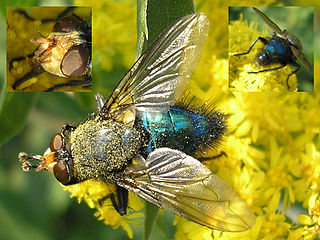 W
WCynomya mortuorum belongs to the order Diptera, sometimes referred to as "true flies". In English, the only common name occasionally used is "fly of the dead". It has a bluish-green appearance, similar to other Calliphoridae and is found in multiple geographic locations with a preference for colder regions. Belonging to the family Calliphoridae, it has been shown to have forensically relevant implications due to its appearance on carrion. Current research is being done to determine C. mortuorum's level of importance and usage within forensic entomology.
 W
WDialineura anilis is a species of ' stiletto flies' belonging to the family Therevidae. It is a Palearctic species with a limited distribution in Europe
 W
WDictenidia bimaculata is a species of cranefly which is widespread throughout the Palaearctic.
 W
WThe early bumblebee or early-nesting bumblebee is a small bumblebee with a wide distribution in most of Europe and parts of Asia. It is very commonly found in the UK and emerges to begin its colony cycle as soon as February which is earlier than most other species, hence its common name. There is even some evidence that the early bumblebee may be able to go through two colony cycles in a year. Like other bumblebees, Bombus pratorum lives in colonies with queen and worker castes. Bombus pratorum queens use aggressive behavior rather than pheromones to maintain dominance over the workers!
 W
WEctobius sylvestris, known generally as the forest cockroach or lesser cockroach, is a species of cockroach in the family Ectobiidae. It is found in Europe & Northern Asia, North America, and temperate Asia.
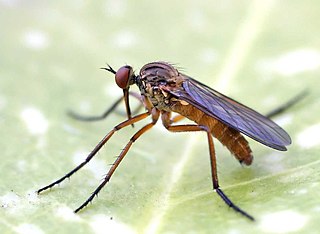 W
WEmpis stercorea is a large species of dance flies, in the fly family Empididae. It is found in most of Europe, except the Iberian Peninsula.
 W
WEpiphragma ocellare is a species of fly in the family Limoniidae. It is found in the Palearctic.
 W
WFormica rufa, also known as the red wood ant, southern wood ant, or horse ant, is a boreal member of the Formica rufa group of ants, and is the type species for that group. It is native to Europe and Anatolia, but is also found in North America, in both coniferous and broad-leaf broken woodland and parkland. Workers are colored red and brownish-black, with a dorsal dark patch on the head and promensonotum, and are polymorphic, measuring 4.5–9 mm in length. They have large mandibles, and like many other ant species, they are able to spray formic acid from their abdomens as a defence. Formic acid was first extracted in 1671 by the English naturalist John Ray by distilling a large number of crushed ants of this species. These ants primarily eat honeydew from aphids. Some groups form large networks of connected nests with multiple queen colonies, while others have single-queen colonies.
 W
WThe green shield bug – Palomena prasina – is a European shield bug species in the family Pentatomidae. The name might equally apply to several other species in the tribe Nezarini, or if referred-to as a "green stink bug", it might more appropriately belong to the larger North American bug, Acrosternum hilare. The adult green shield bug ranges in the colour of their backs from bright green to bronze, without any substantial markings. Green shield bugs are a very common shield bug throughout Europe, including the British Isles, and are found in a large variety of habitats, including gardens. They have been found as far north as 63° N latitude.
 W
WLaphria flava, the bumblebee robberfly, yellow robberfly or yellow assassin fly, is a fly of the Asilidae family.
 W
WThe lesser house fly or little house fly, Fannia canicularis, is somewhat smaller than the common housefly. It is best known for its habit of entering buildings and flying in jagged patterns in the middle of a room. It is slender, and the median vein in the wing is straight. Larvae feed on all manner of decaying organic matter, including carrion.
 W
WLygocoris pabulinus also known as the common green capsid, is a Holarctic species of bug from the family Miridae which can be found throughout Europe. It is an adventive species in North America.Lygocoris pabulinus feeds on a variety of plants.
 W
WMantispa styriaca, the Styrian praying lacewing, is a species of predatory mantidfly native to Europe. It is a yellow-brown insect as an adult and has multiple larval stages.
 W
WMegachile lagopoda is a species of bee in the family Megachilidae. It was described by Carl Linnaeus in 1761.
 W
WMegalomus hirtus, common name bordered brown lacewing, is a species of brown lacewings in the family Hemerobiidae.
 W
WMetrioptera brachyptera is a species in the family Tettigoniidae commonly called the bog bush cricket.
 W
WOncopsis flavicollis is a species of leafhoppers belonging to the family Cicadellidae subfamily Eurymelinae.
 W
WPalomena viridissima is a European species of shield bug in the tribe Nezarini.
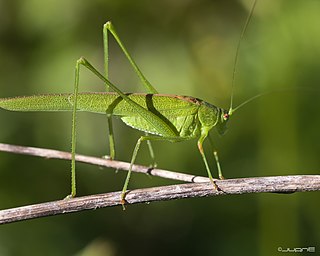 W
WPhaneroptera falcata, the sickle-bearing bush-cricket , is a species of bush-cricket belonging to the family Tettigoniidae subfamily Phaneropterinae. It is herbivorous and commonly measures 24 to 36 mm long. It lives mainly in very warm scrub and grasslands areas. also on dry shrubbery and in sand pits and gardens.
 W
WPolistes gallicus is a fairly common species of paper wasp found in various parts of Europe, excluding England, Denmark, and Scandinavia, from warmer climates to cooler regions north of the Alps. Nests of these social insects are created in these various conditions. The Polistes species use an oral secretion to construct their nests, which consist of a combination of saliva and chewed plant fibers. This structural mixture physically protects the nest from various harsh elements and from weathering over time.
 W
WPsila fimetaria is a species of fly, member of the family Psilidae.
 W
WRhaphigaster nebulosa, common name mottled shieldbug, is a species of stink bugs in the family Pentatomidae. It is the only species of the genus Rhaphigaster.
 W
WRhopalosiphum nymphaeae, the waterlily aphid, is a species of aphid in the family Aphididae. It is found in Europe.
 W
WRhynocoris iracundus is a assassin and thread-legged bug belonging to the family Reduviidae, subfamily Harpactorinae. The species was first described by Nikolaus Poda von Neuhaus in 1761.
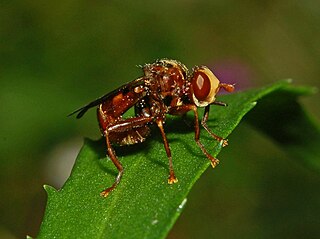 W
WSicus ferrugineus is a species of fly from the genus Sicus in the family Conopidae.
 W
WSymmorphus bifasciatus, the willow mason-wasp, is a species of potter wasp, from the subfamily Eumeninae of the social wasp family Vespidae which is widely distributed in the Palearctic region.
 W
WTabanus autumnalis, the large marsh horsefly, is a medium-sized species of biting horse-fly. It is somewhat scarce compared to T. bromius and T. bovinus. This species shows slightly more of a preference for coastal marsh than some of the other European Tabanus, sometime even found in saltmashes. Wing length is 13–16 mm and about 16–22 mm in body length.
 W
WTachina fera is a species of fly in the genus Tachina of the family Tachinidae. It was first described by Carl Linnaeus in 1761.
 W
WTetrix subulata is a species of groundhopper known as the slender ground-hopper, awl-shaped pygmy grasshopper and the slender grouse locust. It is found across the Palearctic: in North America, across much of Europe and Asia, from the British Isles east to Siberia, and to the southern parts of North Africa.
 W
WTipula maxima is a species of true cranefly.
 W
WTrichiosoma vitellina is a Palearctic species of sawfly.
 W
WTryphon rutilator is a species of the family Ichneumonidae, subfamily Tryphoninae.
 W
WVolucella zonaria, the hornet mimic hoverfly, is a species of hoverfly.